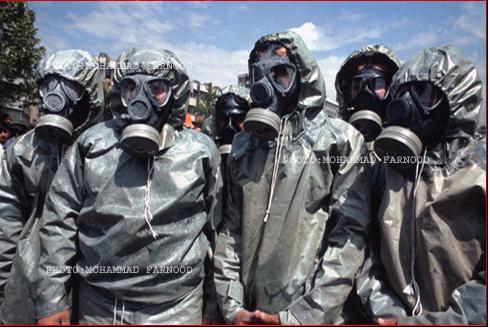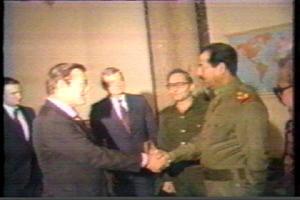1953
|
In
1953, under orders from President Eisenhower, the CIA organized a
military coup that overthrew Iran's democratically elected Prime
Minister Mohammed Mossadegh. Britain,
unhappy that Iran nationalized its oil industry, came up with the idea
for the coup and pressed the United States to mount a joint operation
to remove Mossadeqh (video).
The History of BP/British Petroleum and Its Role in the 1953 Iran Coup (watch)
For years, the U.S.
denied its involvement in the 1953 coup, but in March 2000, then
Secretary of State Madeline Albright admitted, “In 1953 the
United States played a significant role in orchestrating the overthrow
of Iran's popular Prime Minister, Mohammed Mossadeqh. The Eisenhower
Administration believed its actions were justified for strategic
reasons; but the coup was clearly a setback for Iran's political
development. And it is easy to see now why many Iranians continue to
resent this intervention by America in their internal affairs.”
|
Mossadeqh was Time Magazine's Person of the Year in 1951. Following
the coup in 1953, Mossadegh was tried for treason and sentenced to
three years in prison. Following his release he remained under house
arrest until his death ten years later.
|
1953
to
1979
|
Following
the coup, the U.S installed Mohammad Reza Shah Pahlavi , and the
thriving democracy that existed in Iran was crushed. The
Shah led 25 years of tyrannical rule (supported by the CIA) that
resulted in the killing of thousands of Iranians who opposed the U.S.
puppet government.
On the economic front, the Shah denationalized Iran’s oil industry, 60% of which went to American firms.
|

|
| 1979 |
U.S.-backed
Shah of Iran forced to leave the country after widespread
demonstrations and strikes. Islamic religious leader Ayatollah Khomeini
returns from exile and takes effective power.
Sixty-six hostages taken by students at the U.S. embassy in Tehran. The
students justified taking the hostages as retaliation for the admission
of the Shah into the U.S., and demanded the Shah be returned to Iran
for a trial. The new Iranian regime believed the Shah was in the U.S.
so that the U.S. could carry out another coup d'etat in Iran; the U.S.
claimed he had come there only to seek medical attention. The Shah was
given refuge and Iranians demanded his extradition to Iran to face
justice. The U.S. rejected Iran's request and the hostage taking
ensued.
|

The hostage crisis at the U.S. embassy in Tehran lasted 444 days
|
| 1980 |
Iraq
invades neighboring Iran with the approval, if not the assistance of
the United States. The war lasts eight years and kills hundreds
of thousands of Iraqis and Iranians.
Secret U.S. military mission to rescue hostages in Iran ends in
disaster in sandstorm in central Iranian desert. Exiled Shah dies of
cancer in Egypt, but hostage crisis continues.
|

Iran suffered heavy casualties from Saddam's chemical weapons, many of which were provided by the U.S.
|
| 1981 |
Last
52 U.S. hostages freed in January after intense diplomatic activity.
Their release comes a few hours after U.S. President Jimmy Carter
leaves office. They had been held for 444 days. |
|
1982
to
1983
|
As
Iranian forces gained the upper hand on the battlefield with Iraq, the
U.S. launched another covert operation to arm and aid Saddam. It
began clandestinely to supply Saddam with satellite intelligence on
Iran's deployments.
Weapons were also sent via CIA fronts in Chile
and Saudi Arabia directly to Baghdad. Between 1986 and 1989, some
seventy-three transactions took place that included bacterial cultures
to make weapons-grade anthrax, advanced computers, and equipment to
repair jet engines and rockets.
|

Iraqi
President Saddam Hussein greets Donald Rumsfeld, then special envoy of
President Ronald Reagan, in Baghdad on December 20, 1983.
|
1985
to
1986
|
Iran-Contra
Affair: U.S. holds secret talks with Iran and makes weapons shipments,
allegedly in exchange for Iranian assistance in releasing U.S. hostages
in Lebanon. With revelations that profits were illegally channeled to
Nicaraguan rebels, this creates the biggest crisis of Ronald Reagan's
presidency. |
|
| 1987 |
Following
the mining of a U.S. Navy frigate, U.S. forces engage in series of
encounters with Iranian naval forces, including strikes on Gulf oil
platforms. The engagement was code named "Operation Praying
Mantis". The battle, the largest between surface forces since
World War II, sank two Iranian warships and as many as six armed
speedboats.
|

The Iranian Frigate, IS Alvand, attacked by U.S. Navy forces
|
| 1988 |
On
patrol in the Persian Gulf, the USS Vincennes shot down an Iranian
passenger jet that it had mistaken for a hostile Iranian fighter
aircraft. U.S. Navy Captain Will C. Rogers III ordered a single missile
fired from his warship, which hit its target and killed all 290 people
aboard the commercial Airbus. |
|
| 1995 |
President
Clinton imposes oil and trade sanctions on Iran for alleged sponsorship
of "terrorism", seeking to acquire nuclear arms and hostility to the
Middle East peace process. Iran denies the charges. |
|
2002
to
2003
|
U.S. President George W Bush, in his State of the Union address, describes Iran as part of an "axis of evil". The U.S. accuses Iran of seeking to develop a secret nuclear weapons program and refuses to rule out the "military option" in dealing with Iran.
|

Bush branded Iran as part of an "axis of evil"
|
2005
to
2006 |
The
United States is openly attempting to "promote democracy" in Iran by
budgeting $3 million for various Iranian groups. Iran's
ambassador to the United Nations called the plan "a clear violation" of
a 1981 U.S-Iranian agreement in which the U.S. pledged "not to
intervene directly or indirectly, politically or militarily in Iran's
internal affairs."
CIA Analysis Finds Iran Not Developing Nuclear Weapons (read) yet the Bush administration continues to claim Iran is threatening the world with it's supposed nuclear pursuit.
|

Iran's account of its nuclear program failed to satisfy the U.S.
|
| 2007 |
In January, U.S. troops were authorized to kill Iranian "operatives" in Iraq (read), and Israel was reportedly preparing to bomb Iranian nuclear facilities (read).
"American forces could be using their two USAF bases in Bulgaria and
one at Romania's Black Sea coast to launch an attack on Iran in April,"
the Bulgarian news agency Novinite said (read).
Justifications for attacking Iran on shaky ground - A
new U.S. intelligence estimate concluded that Iranian and other
outside meddling is "not likely" a major cause of the bloodshed in Iraq
(read).
US funds terror groups to sow chaos in Iran (read).
Bush sanctions 'black ops' against Iran (read). |
|
Other
Sources: |
|
|
 E-mail: info@stpeteforpeace.org
E-mail: info@stpeteforpeace.org
 E-mail: info@stpeteforpeace.org
E-mail: info@stpeteforpeace.org